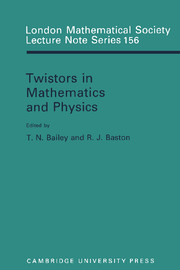Book contents
- Frontmatter
- Preface
- Contents
- 1 Twistor Theory After 25 Years—its Physical Status and Prospects
- 2 Between Integral Geometry and Twistors
- 3 Generalized Conformal Structures
- 4 Riemannian Twistor Spaces and Holonomy Groups
- 5 Twistors, Ambitwistors, and Conformal Gravity
- 6 The Penrose Transform
- 7 Notation for the Penrose Transform
- 8 The Twistor Transform
- 9 Invariant Operators
- 10 Penrose's Quasi-local Mass
- 11 The Sparling 3-form, Ashtekar Variables and Quasi-local Mass
- 12 Twistors and Strings
- 13 Integrable Systems in Twistor Theory
- 14 Twistor Characterization of Stationary Axisymmetric Solutions of Einstein's Equations
- 15 A Two-surface Encoding of Radiative Space-times
- 16 Twistors, Massless Fields and the Penrose Transform
- 17 Twistor Diagrams and Feynman Diagrams
- 18 Cohomology and Twistor Diagrams
- Authors' addresses
1 - Twistor Theory After 25 Years—its Physical Status and Prospects
Published online by Cambridge University Press: 05 May 2013
- Frontmatter
- Preface
- Contents
- 1 Twistor Theory After 25 Years—its Physical Status and Prospects
- 2 Between Integral Geometry and Twistors
- 3 Generalized Conformal Structures
- 4 Riemannian Twistor Spaces and Holonomy Groups
- 5 Twistors, Ambitwistors, and Conformal Gravity
- 6 The Penrose Transform
- 7 Notation for the Penrose Transform
- 8 The Twistor Transform
- 9 Invariant Operators
- 10 Penrose's Quasi-local Mass
- 11 The Sparling 3-form, Ashtekar Variables and Quasi-local Mass
- 12 Twistors and Strings
- 13 Integrable Systems in Twistor Theory
- 14 Twistor Characterization of Stationary Axisymmetric Solutions of Einstein's Equations
- 15 A Two-surface Encoding of Radiative Space-times
- 16 Twistors, Massless Fields and the Penrose Transform
- 17 Twistor Diagrams and Feynman Diagrams
- 18 Cohomology and Twistor Diagrams
- Authors' addresses
Summary
Introduction
The primary objective of twistor theory originally was—and still is—to find a deeper route to the workings of Nature; so the theory should provide a mathematical framework with sufficient power and scope to help us towards resolving some of the most obstinate problems of current physical theory. Such problems must ultimately include: (1) removing the infinities of quantum field theory, (2) ascertaining the nature and origin of symmetry and asymmetry in the classification of particles and in physical interactions, (3) deriving, from some fundamental principle, the strengths of coupling constants and the masses of particles, (4) finding a quantum gravity theory capable of satisfactorily addressing the issues raised by space-time singularities and the structure of space-time in the small, (5) constructing a picture that makes sense of the puzzling non-locality and conceptual peculiarities inherent in the process of quantum measurement. Does twistor theory have anything of significance to contribute concerning these matters? Might it at least point us in some appropriate directions?
I shall comment on these issues individually in a moment. But as things stand, it must be said that the successes of twistor theory to date have been almost entirely in applications within mathematics, rather than in furthering our understanding of the nature of the physical world. I would think of twistor theory's physical role, so far, as being something perhaps resembling that of the Hamiltonian formalism.
- Type
- Chapter
- Information
- Twistors in Mathematics and Physics , pp. 1 - 29Publisher: Cambridge University PressPrint publication year: 1990
- 1
- Cited by

